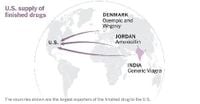It’s been a turbulent August for global trade, and the reverberations could soon be felt in the medicine cabinets of millions of Americans. President Donald Trump’s latest round of tariffs—aimed squarely at India—has sent shockwaves through the pharmaceutical supply chain, raising urgent questions about drug prices, shortages, and the future of U.S.-India relations.
On August 1, 2025, in a move that stunned diplomats and business leaders alike, Trump labeled India a "dead economy" and slapped a 25% tariff on Indian exports to the United States, according to News9. Just a week later, the tariff was doubled to 50%, with Trump citing India’s continued purchases of Russian oil amid Moscow’s ongoing invasion of Ukraine. The escalation didn’t stop there: on August 22, Trump administration advisor Peter Navarro launched a public attack on the Indian government, accusing it of unfair trade practices and defending the administration’s “warrior protectionism.”
But what’s really behind this dramatic policy shift? According to panelists on India’s News9, including journalist Scott Lucas, the tariffs have less to do with geopolitics and more to do with the Trump administration’s penchant for economic brinkmanship. Lucas described the strategy as an attempt to "bully India into economic concessions," a tactic that Indian commentators and former diplomats say should be resisted. Ambassador Deepak Vohra and Dr. Rajan Kumar argued that, unlike the European Union and Japan—which have opted for negotiation and compromise with Washington—India should stand firm against U.S. pressure.
At the heart of the matter is a complex and deeply interconnected global pharmaceutical supply chain. As the New York Times reports, most prescription drugs consumed in the United States are not made in a single country. Instead, the process spans continents: raw materials might originate in China, active ingredients could be synthesized in India, and the final formulation might take place in the U.S. or Europe. This web of production means that tariffs imposed on one country can have ripple effects throughout the system.
Take, for example, the case of generic drugs. India is the world’s leading manufacturer of generic medications, including the vast majority of pills taken by Americans. After the erectile dysfunction drug sildenafil (better known as Viagra) went generic in 2017, Indian factories began producing 98% of the finished product supplied to the U.S., according to data from U.S. Pharmacopeia shared with The New York Times. The same is true for many other essential medicines, from blood pressure tablets like losartan—whose active ingredients are mostly made in China and formulated in India—to antibiotics such as amoxicillin, ciprofloxacin, and doxycycline.
These generics are the backbone of American healthcare, prescribed by the millions every year. But they also operate on razor-thin profit margins, making them highly sensitive to price shocks. Tariffs of 25% or 50% could make it unprofitable for Indian manufacturers to supply the U.S. market, leading to price hikes, shortages, or both. As the New York Times notes, "Tariffs threaten to hit antibiotics particularly hard. The drugs have very thin profit margins, they are vulnerable to shortages and U.S. production is very limited."
The threat doesn’t end with pills. Injectable medicines—such as lidocaine, a hospital staple used to numb pain—are even more vulnerable. Their production is more complex, involving multiple steps and countries. The U.S. relies on imports from India, Portugal, South Korea, and elsewhere for both active ingredients and finished vials. Supply chain experts warn that tariffs could exacerbate already frequent shortages of these vital drugs, putting patient care at risk.
Meanwhile, the landscape for newer, high-cost medications looks different. Patent-protected drugs, like the blockbuster weight-loss injection semaglutide (marketed as Ozempic and Wegovy), have their active ingredients manufactured in Denmark by Novo Nordisk. The company splits the final formulation of these injections between Denmark and the United States. According to Ambre James-Brown, a spokesperson for Novo Nordisk, "most of the company’s manufacturing for a tablet form of the drug is in the United States." But even these European-made drugs aren’t immune to tariff threats. Under a recent trade deal between the U.S. and the European Union, such medications would face a 15% levy, although it remains unclear when the new tariffs will take effect.
All this uncertainty has fueled a broader debate about America’s dependence on foreign drugmakers. Politicians from both parties have raised alarms about national security vulnerabilities, especially when it comes to China’s role in the supply of active pharmaceutical ingredients. Yet, as the data shows, India’s contribution is equally crucial—particularly for the affordable generics that keep healthcare costs in check for millions of Americans.
For India, the stakes are just as high. The country’s pharmaceutical industry is a cornerstone of its economy and a point of national pride. Indian officials and commentators have bristled at Trump’s accusations and the sudden escalation of tariffs. On News9, panelists noted that the Trump administration’s approach stands in stark contrast to the frameworks agreed by the EU and Japan, where negotiation has prevailed over confrontation. Journalist Shweta Kothari and Ambassador Jayant Das Gupta emphasized India’s determination to resist U.S. demands and pursue alternative trading relationships, signaling a potential realignment in global trade alliances.
That realignment may already be underway. As Scott Lucas pointed out, "India will be part of a global realignment bypassing Washington." With U.S.-Indian relations at their lowest ebb in years, both countries are exploring new partnerships and supply routes. For American consumers, however, the immediate concern is what all this will mean for the availability and price of their medications.
It’s a question that defies easy answers. The pharmaceutical supply chain is a delicate balance of cost, quality, and logistics. Disruptions—whether from tariffs, pandemics, or geopolitical tensions—can have far-reaching consequences. As the U.S. government weighs its next moves, patients, pharmacists, and policymakers alike are watching closely, hoping that the medicine cabinet doesn’t become the next casualty of a global trade war.

